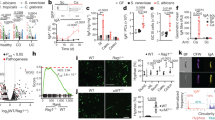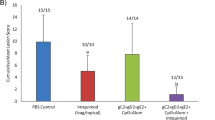Abstract
Two recombinant strains of Streptococcus gordonii, secreting or displaying a microbicidal single-chain antibody (H6), and stably colonizing rat vagina, were used to treat an experimental vaginitis caused by Candida albicans. A post-challenge intravaginal delivery of the H6-secreting strain was as efficacious as fluconazole in rapidly abating the fungal burden. Three weeks after challenge, 75% and 37.5% of the rats treated with the H6-secreting or displaying bacteria, respectively, were cured of the infection, which persisted in 100% of the animals treated with a S. gordonii strain expressing an irrelevant single-chain antibody. Thus, a human commensal bacterium can be suitably engineered to locally release a therapeutic antibody fragment.
This is a preview of subscription content, access via your institution
Access options
Subscribe to this journal
Receive 12 print issues and online access
$209.00 per year
only $17.42 per issue
Buy this article
- Purchase on Springer Link
- Instant access to full article PDF
Prices may be subject to local taxes which are calculated during checkout



Similar content being viewed by others
References
Boyd, M.R. et al. Discovery of cyanovirin-N, a novel human immunodeficiency virus-inactivating protein that binds viral surface envelope glycoprotein gp120: potential applications to microbicide development. Antimicrob. Agents Chemother. 41, 1521–1530 (1997).
Rosenthal, S.L., Cohen, S.S. & Stanberry, L.R. Topical microbicides. Current status and research considerations for adolescent girls. Sex Transm. Dis. 25, 368–377 (1998).
Rex, J.H., Walsh, T.J. & Anaissie, E.J. Fungal infections in iatrogenically compromised hosts. Adv. Intern. Med. 43, 321–371 (1988).
Sobel, J.D. Pathogenesis and epidemiology of vulvovaginal candidiasis. Ann. NY Acad. Sci. 544, 547–557 (1988).
Polonelli, L. & Cassone, A. Novel strategies for treating candidiasis. Curr. Opin. Infect. Dis. 12, 61–66 (1999).
De Bernardis, F. et al. Protective role of anti-mannan and anti-aspartyl proteinase antibodies in an experimental model of Candida albicans vaginitis in rats. Infect. Immun. 65, 3399–3405 (1997).
Cassone, A., Conti, S., De Bernardis, F. & Polonelli, L. Antibodies, killer toxins and antifungal immunoprotection: a lesson from nature? Immunol. Today 18, 164–169 (1997).
Magliani, W., Conti, S., Gerloni, M., Bertolotti, D. & Polonelli, L. Yeast killer systems. Clin. Microbiol. Rev. 10, 369–400 (1997).
Magliani, W. et al. Therapeutic potential of antiidiotypic single chain antibodies with yeast killer toxin activity. Nat. Biotechnol. 15, 155–158 (1997).
Conti, S. et al. Mycobactericidal activity of human natural, monoclonal, and recombinant yeast killer toxin-like antibodies. J. Infect. Dis. 177, 807–811 (1998).
Medaglini, D., Rush, C.M., Sestini, P. & Pozzi, G. Commensal bacteria as vectors for mucosal vaccines against sexually transmitted diseases: vaginal colonization with recombinant streptococci induces local and systemic antibodies in mice. Vaccine 15, 1330–1337 (1997).
Medaglini, D., Oggioni, M.R. & Pozzi, G. Vaginal immunization with recombinant gram-positive bacteria. Am. J. Reprod. Immunol. 39, 199–208 (1998).
Di Fabio, S. et al. Vaginal immunization of Cynomolgus monkeys with Streptococcus gordonii expressing HIV-1 and HPV 16 antigens. Vaccine 16, 485–492 (1998).
Polonelli, L. & Morace, G. Production and characterization of yeast killer toxin monoclonal antibodies. J. Clin. Microbiol. 25, 460–462 (1987).
Oggioni, M.R. & Pozzi, G. A host–vector system for heterologous gene expression in Streptococcus gordonii. Gene 169, 85–90 (1996).
Magliani, W. et al. Neonatal mouse immunity against group B streptococcal infection by maternal vaccination with recombinant antiidiotypes. Nat. Med. 4, 705–709 (1998).
Navarre, W.W. & Schneewind, O. Surface proteins of gram-positive bacteria and mechanisms of their targeting to the cell wall envelope. Microbiol. Mol. Biol. Rev. 63, 174–229 (1999).
Pozzi, G. et al. Delivery and expression of a heterologous antigen on the surface of streptococci. Infect. Immun. 60, 1902–1907 (1992).
Oggioni, M.R. Medaglini, D., Maggi, T. & Pozzi, G. Engineering the gram-positive cell surface for construction of bacterial vaccine vectors. Methods 19, 163–173 (1999).
Ricci, S. et al. Immunogenicity of the B monomer of Escherichia coli heat-labile toxin expressed on the surface of Streptococcus gordonii. Infect. Immun. 68, 760–766 (2000).
De Bernardis, F., Lorenzini, R. & Cassone, A. Rat model of Candida vaginal infection. In Handbook of animal models of infection (eds Zak, O. & Sande, M.A.) 735–740 (Academic Press, New York, NY; 1999).
Osaki, T. et al. Establishment and characterisation of a monoclonal antibody to inhibit adhesion of Helicobacter pylori to gastric epithelial cells. J. Med. Microbiol. 47, 505–512 (1998).
Kelly, C.G. et al. A synthetic peptide adhesion epitope as a novel antimicrobial agent. Nat. Biotechnol. 17, 42–47 (1999).
Kokryakov, V.N. et al. Protegrins: leukocyte antimicrobial peptides that combine features of corticostatic defensins and tachyplesins. FEBS Lett. 327, 231–236 (1993).
Boyd, M.R. The position of intellectual property rights in drug discovery and development from natural products. J. Ethnopharmacol. 51, 17–25 (1996).
Qu, X.D., Harwig, S.S., Shafer, W.M. & Lehrer, R.I. Protegrin structure and activity against Neisseria gonorrhoeae. Infect. Immun. 65, 636–639 (1997).
Polonelli, L. et al. Monoclonal yeast killer toxin-like candidacidal antiidiotypic antibodies. Clin. Diagn. Lab. Immunol. 4, 142–146 (1997).
Séguy, N., Polonelli, L., Dei-Cas, E. & Cailliez, J.C. Perspectives in the control of Pneumocystis infections by using Pichia anomala killer toxin-like antiidiotypic antibodies. FEMS Immunol. Med. Microbiol. 22, 145–149 (1998).
Oggioni, M.R., Manganelli, R., Contorni, M., Tommasino, M. & Pozzi, G. Immunization of mice by oral colonization with live recombinant commensal streptococci. Vaccine 13, 775–779 (1995).
Fidel, P.L. & Sobel, J.D. Immunopathogenesis of recurrent vulvovaginal candidiasis. Clin. Microbiol. Rev. 9, 335–348 (1996).
Klein, R.S. et al. Oral candidiasis in high-risk patients as the initial manifestation of the acquired immunodeficiency syndrome. N. Engl. J. Med. 311, 354–358 (1984).
Cauda, R. et al. Role of protease inhibitors in preventing recurrent oral candidiasis in patients with HIV infection: a prospective case-control study. J. Acquir. Immun. Def. Syndr. 21, 20–25 (1999).
Alexander, B.D. & Perfect, J.R. Antifungal resistance trends towards the year 2000. Implications for therapy and new approaches. Drugs 54, 657–678 (1997).
Sobel, J. & Muller, G. Comparison of itraconazole and ketoconazole in the treatment of experimental candidal vaginitis. Antimicrob. Agents Chemoter. 26, 266–267 (1984).
Cassone, A., Boccanera, M., Ariani, D., Santoni, G. & De Bernardis F. Rats clearing a vaginal infection by Candida albicans acquire specific antibody-mediated resistance to vaginal reinfection. Infect. Immun. 63, 2619–2624 (1995).
Polonelli, L. et al. Human natural yeast killer toxin-like, candidacidal antibodies. J. Immunol. 156, 1880–1885 (1996).
Hancock, R.E. & Lehrer, R. Cationic peptides: a new source of antibiotics. Trends Biotechnol. 16, 82–88 (1998).
Acknowledgements
This work was supported by grants from the Commission of the European Union (fifth frame work contract QLK2-1999-00854) to MRO; from CNR (P. F. Biotecnologie, contract no. 97.01185.PF49) to GP and GT; from the Progetto Nazionale AIDS 1998 (contract no. 50B.32) to LP, and from the Progetto Nazionale AIDS 1998 (contract no. 50C/B) to AC.
Author information
Authors and Affiliations
Corresponding author
Rights and permissions
About this article
Cite this article
Beninati, C., Oggioni, M., Boccanera, M. et al. Therapy of mucosal candidiasis by expression of an anti-idiotype in human commensal bacteria. Nat Biotechnol 18, 1060–1064 (2000). https://doi.org/10.1038/80250
Received:
Accepted:
Issue Date:
DOI: https://doi.org/10.1038/80250
This article is cited by
-
Towards a universal influenza vaccine: different approaches for one goal
Virology Journal (2018)
-
IL-1Ra and its Delivery Strategies: Inserting the Association in Perspective
Pharmaceutical Research (2013)
-
From Pichia anomala killer toxin through killer antibodies to killer peptides for a comprehensive anti-infective strategy
Antonie van Leeuwenhoek (2011)
-
Identification of restriction endonuclease with potential ability to cleave the HSV-2 genome: Inherent potential for biosynthetic versus live recombinant microbicides
Theoretical Biology and Medical Modelling (2008)
-
Mucosal delivery of therapeutic and prophylactic molecules using lactic acid bacteria
Nature Reviews Microbiology (2008)



